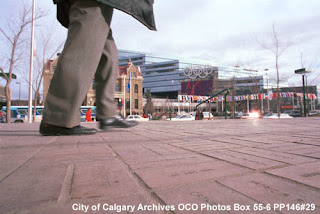One of Calgary's best-known landmarks is Olympic Plaza, the public square opposite City Hall that was developed in advance of the XV Olympic Winter Games in 1988. Few people, howver, would use the word "landmark" to describe the plaine, one-storey structure that stood on the corner from 1912 to 1985.
But it was a landmark to the shoppers and merchants who from 1919 to 1951 knew it as the City Hall Market.
Despite its longevity, the building was originally planned as a temporary structure. At the height of the pre-First World War Calgary construction boom in 1912, the Dominion government determined that the Calgary post office and federal building at the southeast corner of 8th Avenue and 1st Street SE was too small. The old sandstone post office, built in 1894, was demolished in 1913. Ottawa planned to replace it immediately with a substantial new edifice.
Meanwhile, a temporary replacement was designed for a site a block away, at the southwest corner of 7th Avenue and 2nd Street SE. One hundred years ago today—on October 25, 1912—a building permit was issued for that new, temporary structure.
By the end of 1913, however, the economy came to a halt and Calgary's boom went bust. Meanwhile, the "temporary" post office served until 1919, when the post office was moved to the Lancaster Building. It took until 1931 before the new post office, the Calgary Public Building—which now houses the foyer of the Jack Singer Concert Hall—was built.
The "temporary" post office building was sold to Theodore J. Klossoski and began operations in 1919 as City Hall Market, a retail complex with over 40 stalls, including bakers, confectioners, fishmongers, meat merchants, and grocers. Many of the vendors were Jewish, including Norman Gould, whose meat market operated there for over three decades.
In January 1953, The City of Calgary took over the City Hall Market building and turned it into City Hall Annex, which housed offices of the engineering department. Later, the building became a Bank of Montreal branch. In its final function, it housed the offices of the Calgary Centre for Performing Arts (now the Epcor Centre for the Performing Arts) while that complex was under construction.

In 1985, the former City Hall Market was demolished to make way for Olympic Plaza.
(Adapted from Harry Sanders, "City Hall Market Home to Many Jewish Vendors," Discovery: The Journal of the Jewish Historical Society of Southern Alberta 10:2 [2000]: 1-2.)
In February 1988, Calgary played host to the world during the XV Olympic Winter Games. A year earlier, the $5.7-million Olympic Plaza opened across the street from City Hall. Citizens were given the chance to buy bricks with personal inscriptions for $19.88 each. City of Calgary, Corporate Records, Archives OCO Photos Box 55-6 PP146#29





